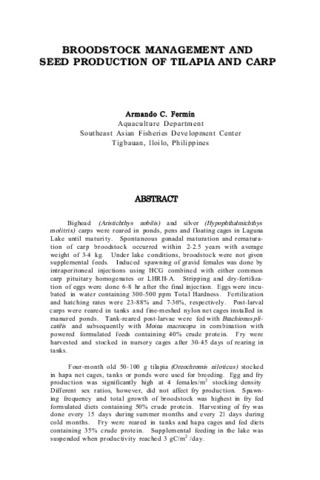Toxicity of four botanical insecticides to fingerlings of Nile tilapia and common carp
| dc.contributor.author | Leaño, Eduardo M. | |
| dc.contributor.author | Cagauan, Arsenia G. | |
| dc.contributor.editor | Chou, L. M. | |
| dc.contributor.editor | Munro, A. D. | |
| dc.contributor.editor | Lam, T. J. | |
| dc.contributor.editor | Chen, T. W. | |
| dc.contributor.editor | Cheong, L. K. K. | |
| dc.contributor.editor | Ding, J. K. | |
| dc.contributor.editor | Hooi, K. K. | |
| dc.contributor.editor | Khoo, H. W. | |
| dc.contributor.editor | Phang, V. P. E. | |
| dc.contributor.editor | Shim, K. F. | |
| dc.contributor.editor | Tan, C. H. | |
| dc.date.accessioned | 2011-06-22T09:35:32Z | |
| dc.date.available | 2011-06-22T09:35:32Z | |
| dc.date.issued | 1994 | |
| dc.identifier.uri | http://hdl.handle.net/10862/382 | |
| dc.description.abstract | Static bioassay test was done to determine the toxicity of four botanical insecticides (BI) - Blumea balsamifera leaves, Vitex negundo leaces, Azadirachta indica seeds, Tinospora rumphii stems to fingerlings (0.8 - 1.5g) nile tilapia (Oreochromis niloticus) and common carp (Cyprinus carpio). Median lethal concentration (g/1) obtained at 96 - hour of exposure for O. niloticus and C. carpio, respectively, were 1.54 and 137 (B. balsamifera), 4.95 and 3.53 (V. negundo), 1.59 and 0.55 (A.indica), and, 0.77 and 2.13 (T. rumphii). Analysis on the levels of toxicity of each BI showed that A. indica was the most toxic to O. niloticus to C. carpio, at 24 - h of exposure. At 96 - h, however, B. balsamifera and T. rumphii appeared to be the most toxic to O. niloticus while T. rumphii to C. carpio. V. negundo was the least toxic to both test species. Results of this study could be used as basis for field application rates of the test botanicals as piscicide in ponds and as insecticide in pest management rice-fish farming. | en |
| dc.language.iso | en | en |
| dc.publisher | Asian Fisheries Society | en |
| dc.relation.ispartof | In: Chou, L.M., Munro, A.D., Lam, T.J., Chen, T.W., Cheong, L.K.K., Ding, J.K., Hooi, K.K., Khoo, H.W., Phang, V.P.E., Shim, K.F., Tan, C.H. (eds.). The Third Asian Fisheries Forum. Proceedings of the Third Asian Fisheries Forum, 26-30 October 1992, Singapore. Manila, Philippines: Asian Fisheries Society. pp. 492-495 | en |
| dc.subject | Botanical resources | en |
| dc.subject | Philippines | en |
| dc.subject | tilapia | en |
| dc.subject | carp | en |
| dc.subject | common carp | en |
| dc.subject | Nile tilapia | en |
| dc.subject | Tilapia nilotica | en |
| dc.subject | Cyprinus carpio | en |
| dc.subject | Azadirachta indica | en |
| dc.subject | Vitex negundo | en |
| dc.subject | Blumea balsamifera | en |
| dc.subject.lcc | VF SP 179 | |
| dc.title | Toxicity of four botanical insecticides to fingerlings of Nile tilapia and common carp | en |
| dc.type | Conference paper | en |
| dc.citation.spage | 492 | |
| dc.citation.epage | 495 | |
| dc.citation.conferenceTitle | The Third Asian Fisheries Forum. Proceedings of the Third Asian Fisheries Forum, 26-30 October 1992, Singapore | en |
| dc.subject.asfa | food fish | en |
| dc.subject.asfa | tilapia culture | en |
| dc.subject.asfa | carp culture | en |
| dc.subject.asfa | insecticides | en |
| dc.subject.asfa | toxicity tests | en |
| dc.subject.asfa | fingerlings | en |
| dc.subject.scientificName | Tinospora rumphii | en |
Files in this item
| Files | Size | Format | View |
|---|---|---|---|
|
There are no files associated with this item. |
|||
This item appears in the following Collection(s)
-
Conference Proceedings [300]


